I try to implement the Fourier series function according to the following formulas:

...where...

...and...


Here is my approach to the problem:
import numpy as np
import pylab as py
# Define "x" range.
x = np.linspace(0, 10, 1000)
# Define "T", i.e functions' period.
T = 2
L = T / 2
# "f(x)" function definition.
def f(x):
return np.sin(np.pi * 1000 * x)
# "a" coefficient calculation.
def a(n, L, accuracy = 1000):
a, b = -L, L
dx = (b - a) / accuracy
integration = 0
for i in np.linspace(a, b, accuracy):
x = a + i * dx
integration += f(x) * np.cos((n * np.pi * x) / L)
integration *= dx
return (1 / L) * integration
# "b" coefficient calculation.
def b(n, L, accuracy = 1000):
a, b = -L, L
dx = (b - a) / accuracy
integration = 0
for i in np.linspace(a, b, accuracy):
x = a + i * dx
integration += f(x) * np.sin((n * np.pi * x) / L)
integration *= dx
return (1 / L) * integration
# Fourier series.
def Sf(x, L, n = 10):
a0 = a(0, L)
sum = 0
for i in np.arange(1, n + 1):
sum += ((a(i, L) * np.cos(n * np.pi * x)) + (b(i, L) * np.sin(n * np.pi * x)))
return (a0 / 2) + sum
# x axis.
py.plot(x, np.zeros(np.size(x)), color = 'black')
# y axis.
py.plot(np.zeros(np.size(x)), x, color = 'black')
# Original signal.
py.plot(x, f(x), linewidth = 1.5, label = 'Signal')
# Approximation signal (Fourier series coefficients).
py.plot(x, Sf(x, L), color = 'red', linewidth = 1.5, label = 'Fourier series')
# Specify x and y axes limits.
py.xlim([0, 10])
py.ylim([-2, 2])
py.legend(loc = 'upper right', fontsize = '10')
py.show()
...and here is what I get after plotting the result:

I've read the How to calculate a Fourier series in Numpy? and I've implemented this approach already. It works great, but it use the expotential method, where I want to focus on trigonometry functions and the rectangular method in case of calculating the integraions for a_{n} and b_{n} coefficients.
Thank you in advance.
UPDATE (SOLVED)
Finally, here is a working example of the code. However, I'll spend more time on it, so if there is anything that can be improved, it will be done.
from __future__ import division
import numpy as np
import pylab as py
# Define "x" range.
x = np.linspace(0, 10, 1000)
# Define "T", i.e functions' period.
T = 2
L = T / 2
# "f(x)" function definition.
def f(x):
return np.sin((np.pi) * x) + np.sin((2 * np.pi) * x) + np.sin((5 * np.pi) * x)
# "a" coefficient calculation.
def a(n, L, accuracy = 1000):
a, b = -L, L
dx = (b - a) / accuracy
integration = 0
for x in np.linspace(a, b, accuracy):
integration += f(x) * np.cos((n * np.pi * x) / L)
integration *= dx
return (1 / L) * integration
# "b" coefficient calculation.
def b(n, L, accuracy = 1000):
a, b = -L, L
dx = (b - a) / accuracy
integration = 0
for x in np.linspace(a, b, accuracy):
integration += f(x) * np.sin((n * np.pi * x) / L)
integration *= dx
return (1 / L) * integration
# Fourier series.
def Sf(x, L, n = 10):
a0 = a(0, L)
sum = np.zeros(np.size(x))
for i in np.arange(1, n + 1):
sum += ((a(i, L) * np.cos((i * np.pi * x) / L)) + (b(i, L) * np.sin((i * np.pi * x) / L)))
return (a0 / 2) + sum
# x axis.
py.plot(x, np.zeros(np.size(x)), color = 'black')
# y axis.
py.plot(np.zeros(np.size(x)), x, color = 'black')
# Original signal.
py.plot(x, f(x), linewidth = 1.5, label = 'Signal')
# Approximation signal (Fourier series coefficients).
py.plot(x, Sf(x, L), '.', color = 'red', linewidth = 1.5, label = 'Fourier series')
# Specify x and y axes limits.
py.xlim([0, 5])
py.ylim([-2.2, 2.2])
py.legend(loc = 'upper right', fontsize = '10')
py.show()
